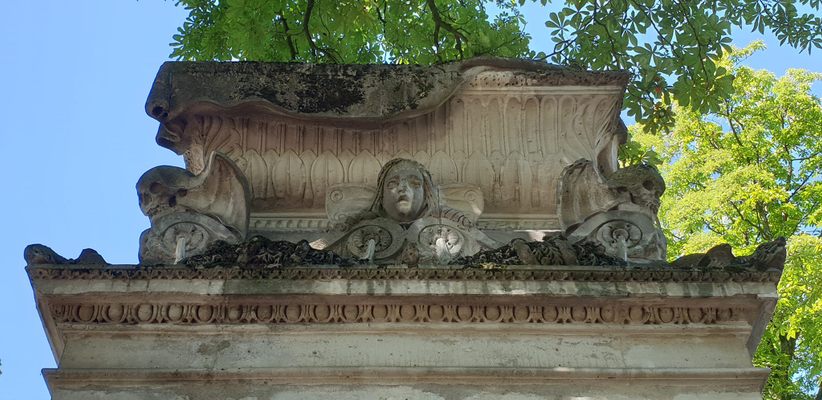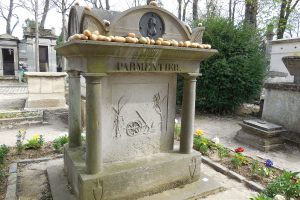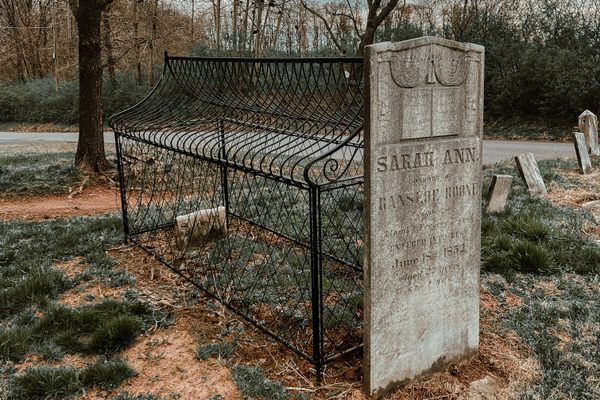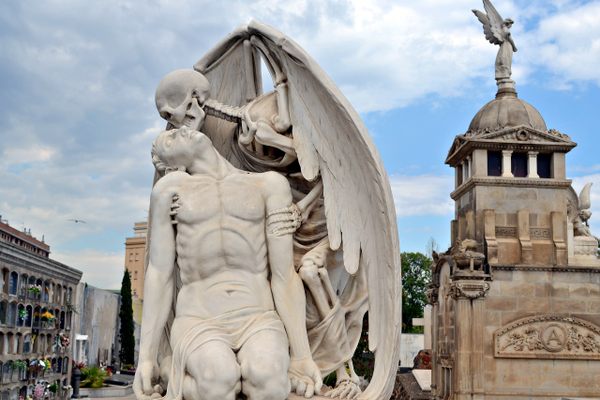About
Select any day in the life of Étienne-Gaspard Robertson (1763-1837) and you might find the Liège-born artist and scientist conducting experiments in electricity, floating through the sky in a hot air balloon, or conjuring demons and the ghosts of French luminaries such as Marat and Rousseau. But it's these necromantic arts that most distinguish his towering tomb in Cimitière du Père Lachaise.
Robertson spent his young adulthood in Paris during the height of the Terror. He was a talented painter from an early age, and made a living through small painting commissions while attending lectures on the burgeoning science of electricity. A tutoring post in a wealthy household enabled him to learn mathematics and physics from his benefactor's educated brother, further advancing his intellectual talents. These combined talents were first applied in a plan to construct Archimedes' light-reflecting death ray for the government of France. The project went nowhere, but preparing for it gave Robertson a practical, working knowledge of optics that inspired his experiments in what would become his lasting legacy: elaborate horror spectacles known as phantasmagoria.
Robertson improved upon existing magic lantern spook shows with more advanced lenses, smoke, and sound effects, extravagantly painted creatures and ghosts of historical figures, ventriloquism, eerie glass harmonica music, and gothic theatricality. In the candle-lit gloom of the Convent of the Capucines' crumbling ruins, ghosts, demons, and skeletons were projected onto smoke screens and thin transparent fabrics, where they seemed to rise from tombs and skulk about the darkened crypt to the audience's shock and delight. His performances thrilled and terrified Parisians for four years before traveling around Europe and North America, setting new and much-imitated standards for phantasmagoric arts along the way.
The phantasmagoria remains Robertson's most enduring legacy, eclipsing his scientific contributions to optics and his pioneering use of hot air balloons to collect atmospheric and meteorological data. His grave is a testament to this legacy. Designed by Charles Guillard and sculpted by François Hardouin, the predominant motif is the macabre and spectacular. The three-level tomb is topped by a partially draped sarcophagus with grimacing, bat-winged skulls perched at each corner. Owls stand sentry at the middle level, which displays bas-reliefs celebrating chapters of Robertson's career. One depicts a crowd observing the flight of a hot-air balloon—a figure standing on a barrel is said to represent Benjamin Franklin, icon of electricity. The other features demons, skeletons, and other underworld creatures advancing upon huddled onlookers, some of whom avert their eyes or turn away in horror.
Along with his dates and places of birth and death, the tomb lists some of Robertson's endeavors in life, including physique (physics) and aerostats. But it is the word "fantasmagorie" that appears most worn, perhaps eroded from generations of pencil rubbings by admirers and curiosity seekers.
If, as David Downie contends in Paris, Paris: Journey into the City of Light (2005), the grave has become a pilgrimage site for occultists and for Satanists' black masses, they might be disappointed to learn that Robertson promoted a more skeptical view of the ineffable. He always insisted that his spectacles' purpose was to demonstrate the techniques skilled charlatans could use to manipulate audiences into accepting the reality of the supernatural. Yet it is his unparalleled flair for the macabre, rather than his insistence on rationality and skepticism, that has provided Robertson with an enduring afterlife.
Related Tags
Know Before You Go
The nearest metro station is Phillipe Auguste, Line 2. Enter Père Lachaise Cemetery at 16 Rue du Repos, then make a right on Avenue Casimir Perrier. The tomb is located just before you reach Chemin Serré on the lefthand side.
Published
September 29, 2023
Sources
- Zeitler, William, "E.G. Robertson," https://web.archive.org/web/20080612043656/http://www.glassarmonica.com/armonica/history/creative/robertson.php
- Wikipedia, "Étienne-Gaspard Robert," https://fr.wikipedia.org/wiki/Étienne-Gaspard_Robert
- Robertson, Étienne-Gaspard, Mémoires récréatifs, scientifiques et anecdotiques d'un physicien-aéronaute, Vol. 2, https://archive.org/details/mmoiresrcratifss02robe/page/n3/mode/2up
- Robertson, Étienne-Gaspard, Mémoires récréatifs, scientifiques et anecdotiques d'un physicien-aéronaute, Vol. 1, https://archive.org/details/mmoiresrcratifss01robe
- Meier, Alison, "Robertson’s Fantastic Phantasmagoria, An 18th Century Spectacle of Horror," May 9, 2013, Atlas Obscura, https://www.atlasobscura.com/articles/robertsons-fantastic-phantasmagoria
- Downie, David, Paris, Paris: Journey into the City of Light, Transatlantic Press, 2005.
- Dickens, Charles, "Robertson, Artist in Ghosts," Household Words, Vol. 10:253, page 553, January 27, 1855. https://www.djo.org.uk/household-words/volume-x/page-553.html
- Amis et Passionés du Père Lachaise, "ROBERTSON, Etienne Gaspard ROBERT dit (1763-1837)," https://www.appl-lachaise.net/robertson-etienne-gaspard-robert-dit-1763-1837/























































